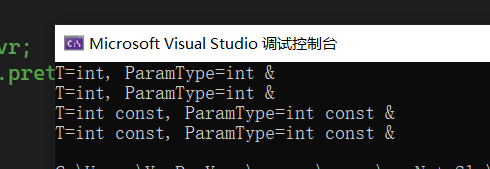在调用模板(函数)的时候,编译器会根据实参类型推导模板参数类型和函数参数类型,从而实例化出对应的函数。通常模板参数类型的推导结果与函数参数类型的推导结果不一样,这是因为函数参数类型会有诸如 const、reference、volatile 等修饰符。模板参数类型的推导结果 不仅取决于实参类型 还依赖函数参数类型的形式 ,本文只讨论其中两种形式------函数参数类型组成部分包含指针或引用,但不是万能引用、函数参数组成部分既没有指针也没有引用。
如下代码片段 T,即模板参数类型;ParamType,为函数参数类型(形式);expr 为实参,其类型是 int。
cpp
template<typename T>
void foo(ParamType v) {
}
int expr = 9;
foo(expr);一、ParamType 是个引用(指针)但不是万能引用时 T 的推导规则
- 如果实参(expr)含有引用,先将其引用部分忽略;
- 然后把 expr 的类型和 ParamType的类型进行模式匹配,进而确定 T 的类型。
二、ParamType 既非指针也非引用时 T 的推导规则
- 如果实参(expr)含有引用,则忽略其引用部分;
- 忽略实参引用性之后,若实参是个const对象,就要忽略 const、同样若实参是个 volatile 对象,也要忽略 volatile。
三、推导过程举例
上文提到 ParamType 的形式决定T的推导结果,接下来一一列举 ParamType 的各种形式的推导过程:
- ParamType 为 T& 形式
可以看到推导结果输出内容显示:T 被推到为 int 或 const int,ParamType 则对应为 int& 或 const int&。当调用者向引用类型的函数参数传入const 对象时,意味着不希望在函数体内修改该对象,所以应该将实参的常量性(constness)成为模板参数T的类型推导结果的组成部分。虽然调用者传入了带引用性(reference-ness)的实参,但是在推导过程中忽略了其引用性(reference-ness),所以模板参数T的类型推导结果中不包含引用部分。
cpp
#include <iostream>
#include <boost/type_index.hpp>
template<typename T>
static inline void test_ref_pattern(T& v) {
using boost::typeindex::type_id_with_cvr;
using std::cout;
using std::endl;
cout << "T=" << type_id_with_cvr<T>().pretty_name()
<< ", ParamType="
<< type_id_with_cvr<decltype(v)>().pretty_name() << endl;
}
int main() {
int x = 66;
const int cx = x;
int& ref = x;
const int& cref = ref;
test_ref_pattern(x);
test_ref_pattern(ref);
test_ref_pattern(cx);
test_ref_pattern(cref);
}
- ParamType 为 const T& 形式
当函数参数类型添加 const 属性时,模板参数的类型推导结果、函数参数的类型推导结果与上边有所差异:由于函数参数中已经包含常量性(constness),所以模板参数的类型推导结果就没包含 const 必要了。
cpp
template<typename T>
void test_const_ref_pattern(const T &v) {
using boost::typeindex::type_id_with_cvr;
using std::cout;
using std::endl;
cout << "T=" << type_id_with_cvr<T>().pretty_name()
<< ", ParamType="
<< type_id_with_cvr<decltype(v)>().pretty_name() << endl;
}
int main()
{
int x = 66;
const int cx = x;
int& ref = x;
const int& cref = ref;
test_const_ref_pattern(x);
test_const_ref_pattern(ref);
test_const_ref_pattern(cx);
test_const_ref_pattern(cref);
}
- ParamType 为 T 形式
这种形式下意味着实参按照"值传递"。这样即使实参有 const 属性,形参仍可不具备 const 属性,换句话说实参不能被修改并不能说明形参在函数体内不能被修改。所以实参的常量性(constness)和挥发性(volatileness)可以在推导过程中忽略。需要重点说明的是去除这两种属性仅发生在"值形参"模式时。
cpp
template<typename T>
void test_value_pattern(T v) {
using boost::typeindex::type_id_with_cvr;
using std::cout;
using std::endl;
cout << "T=" << type_id_with_cvr<T>().pretty_name()
<< ", ParamType="
<< type_id_with_cvr<decltype(v)>().pretty_name() << endl;
}
int main()
{
int x = 66;
const int cx = x;
int& ref = x;
const int& cref = ref;
test_value_pattern(x);
test_value_pattern(ref);
test_value_pattern(cx);
test_value_pattern(cref);
}
- 传递具有顶层const和底层const的实参传递
这种情况类型推导过程中p所指对象的常量性得以保留,p的常量性会在复制形参过程中被忽略。
cpp
int main()
{
const char* const p = "fun with pointer";
test_value_pattern(p);
}
四、总结
这一部分的类型推导法则主要是和C++11之前版本相关的,类型推导过程中按照普通函数的传参规则对const属性进行了取舍、这些行为主要依赖函数参数的表达方式。模板参数的类型按照"最小原则"推导,也就是说T放到函数参数中能清楚表达形参类型就可以了。后续部分会继续探索C++11万能引用相关的类型推导。